Post Construction Green Infrastructure Performance Monitoring Parameters and Their Functional Components
Abstract
:1. Introduction
2. Increasing Green Infrastructure Practices in Public Parks: Benefits and Tradeoffs
3. Barriers to Implementing Green Infrastructure Practices
4. Potential Solutions for Overcoming Barriers
5. Developing Monitoring and Evaluation
6. Quantitative and Qualitative Functional Components of Performance Monitoring Variables
7. Conclusions
Conflicts of Interest
References
- Benedict, M.A.; McMahon, E.T. Green Infrastructure: Smart Conservation for the 21st Century. Renew. Resour. J. 2002, 20, 12–17. [Google Scholar]
- Coffman, L.; Green, R.; Clar, M.; Bitter, S. Development of bioretention practices for stormwater management. In Water Management in the 90’s: A Time for Innovation; Hon, K., Ed.; American Society of Civil Engineers (ASCE): Reston, VA, USA, 1993; pp. 126–129. [Google Scholar]
- Guo, Q.; Correa, C. The Impacts of Green Infrastructure on Flood Level Reduction for the Raritan River: Modelling Assessment. In Proceedings of the World Environmental and Water Resources Congress 2013, Cincinnati, OH, USA, 19–23 May 2013.
- Hager, M.C. Low-impact development: Lot-level approaches to stormwater management are gaining ground. Stormwater 2003, 4, 12–25. [Google Scholar]
- James, P.; Tzoulas, K.; Adams, M.D.; Barber, A.; Box, J.; Breuste, J.; Elmqvistf, T.; Frithg, M.; Gordonh, C.; Greeningi, K.L.; et al. Towards an integrated understanding of green space in the European built environment. Urban. For. Urban. Green. 2009, 8, 65–75. [Google Scholar] [CrossRef]
- Weber, T.; Sloan, A.; Wolf, J. Maryland’s Green Infrastructure Assessment: Development of a comprehensive approach to land conservation. Landsc. Urban. Plan. 2006, 77, 94–110. [Google Scholar] [CrossRef]
- Wright, H. Understanding green infrastructure: The development of a contested concept in England. Local Environ. 2011, 16, 1003–1019. [Google Scholar] [CrossRef]
- Jaffe, M.S.; Zellner, M.; Minor, E.; Gonzalez-Meler, M.; Cotner, L.; Massey, D.; Ahmed, H.; Elberts, M.; Sprague, H.; Wise, S. Using Green Infrastructure to Manage Urban Stormwater Quality: A Review of Selected Practices and State Programs; Illinois Environmental Protection Agency: Springfield, IL, USA, 2010. [Google Scholar]
- LaFortezza, R.; Davies, C.; Sanesi, G.; Konijnendijk, C. Green infrastructure as a tool to support spatial planning in European urban regions. iForest 2012, 6, 102–108. [Google Scholar] [CrossRef]
- Pugh, T.A.; Mackenzie, A.R.; Whyatt, J.D.; Hewitt, C.N. Effectiveness of green infrastructure for improvement of air quality in urban street canyons. Environ. Sci. Technol. 2012, 46, 7692–7699. [Google Scholar] [CrossRef] [PubMed]
- Wise, S.; Braden, J.; Ghalayini, D.; Grant, J.; Kloss, C.; Macmullan, E.; Morse, S.; Montalto, F.; Nees, D.; Nowak, D. Integrating Valuation Methods to Recognize Green Infrastructure’s Multiple Benefits; Center for Neighborhood Technology: Chicago, IL, USA, 2010. [Google Scholar]
- Maimone, M.; O’Rourke, D.E.; Knighton, J.O.; Thomas, C.P. Potential Impacts of Extensive Stormwater Infiltration in Philadelphia. Environ. Eng. Appl. Res. Pract. Fall 2011, 14, 29–39. [Google Scholar]
- Naumann, S.; McKenna, D.; Kaphengst, T. Design, Implementation and Cost Elements of Green Infrastructure Projects; Contract No. 070307/2010/577182/ETU/F.1; Final Report to the European Commission, DG Environment: Brussels, Belgium, December 2011. [Google Scholar]
- Nicol, C.; Blake, R. Classification and use of open space in the context of increasing urban capacity. Plan. Pract. Res. 2000, 15, 193–210. [Google Scholar] [CrossRef]
- Wossink, A.; Hunt, B. An Evaluation of Costs and Benefits of Structural Stormwater Best Management Practices in North Carolina; NC Cooperative Extension Service: Raleigh, NC, USA, 2003. [Google Scholar]
- Layke, C. Measuring Nature’s Benefits: A Status Report and Action Agenda for Improving Ecosystem Services Indicators. Mainstreaming Ecosystem Services—Policy; World Resources Institute: Washington, DC, USA, 2009. [Google Scholar]
- McCormack, S.M.; Sturgill, R.E.; Howell, B.; Van Dyke, C.W.; Kreis, D. Green Infrastructure; Kentucky Transportation Center: Lexington, KY, USA, 2014. [Google Scholar]
- Meng, T.; Hsu, D.; Wadzuk, B. Green Stormwater Infrastructure Use and Perception on Related Smart Services: The Case of Pennsylvania. In Proceedings of the World Environmental and Water Resources Congress, West Palm Beach, Florida, USA, 22–26 May 2016; pp. 59–68.
- Walker, C. The Public Value of Urban Parks. Beyond Recreation: A Broader View of Urban Parks; The Urban Institute: Washington, DC, USA, 2004. [Google Scholar]
- Struck, S.D.; Field, R.; Pitt, R.; O’Bannon, D.; Schmitz, E.; Ports, M.A.; Moore, G. Green infrastructure for CSO control in Kansas City, Missouri. In Proceedings of the 2009 Water Environment Federation Technical Exposition and Conference, Orlando, FL, USA, 10–14 October 2009.
- Williamson, K.S. Growing with Green Infrastructure; Heritage Conservancy: Doylestown, PA, USA, 2003. [Google Scholar]
- Andersen, C.T.; Foster, I.D.L.; Pratt, C.J. The role of urban surfaces (permeable pavements) in regulating drainage and evaporation: Development of a laboratory 12 simulation experiment. Hydrol. Processes 1999, 13, 597–609. [Google Scholar] [CrossRef]
- Benedict, M.A.; McMahon, E.T. Green Infrastructure; Island Press: Washington, DC, USA, 2006. [Google Scholar]
- McDonald, L.; Allen, W.; Benedict, M.; O’connor, K. Green infrastructure plan evaluation frameworks. J. Conserv. Plan. 2005, 1, 12–43. [Google Scholar]
- Backstrom, M. Grassed swales for stormwater pollution control during rain and snowmelt. Water Sci. Technol. 2003, 48, 123–132. [Google Scholar] [PubMed]
- Lindsay, N.; Suparno, O.; Ningsih, D. An Empirical Investigation of the Barriers to Green Practices in Yogyakarta Leather Tanning SMEs. In Proceedings of the International Conference on Adaptive and Intelligent Agroindustry (ICAIA), IEEE Indonesia Section, Bogor, Indonesia, 3–4 August 2015; pp. 260–266.
- Perales-Momparler, S.; Andrés-Doménech, I.; Hernández-Crespo, C.; Vallés-Morán, F.; Martín, M.; Escuder-Bueno, I.; Andreu, J. The role of monitoring sustainable drainage systems for promoting transition towards regenerative urban built environments: A case study in the Valencian region, Spain. J. Clean. Prod. 2016, in press. [Google Scholar] [CrossRef]
- Sandström, U.G.; Angelstam, P.; Khakee, A. Urban comprehensive planning–identifying barriers for the maintenance of functional habitat networks. Landsc. Urban. Plan. 2006, 75, 43–57. [Google Scholar] [CrossRef]
- Thorne, C.R.; Lawson, E.C.; Ozawa, C.; Hamlin, S.L.; Smith, L.A. Overcoming uncertainty and barriers to adoption of Blue-Green Infrastructure for urban flood risk management. J. Flood Risk Manag. 2015. [Google Scholar] [CrossRef]
- Wu, J.S.; Allan, C.J.; Saunders, W.L.; Evett, J.B. Characterization and pollutant loading estimation for highway runoff. J. Environ. Eng. 1998, 124, 584–592. [Google Scholar] [CrossRef]
- Greenhalgh, T.; Robert, G.; Macfarlane, F.; Bate, P.; Kyriakidou, O. Diffusion of innovations in service organizations: Systematic review and recommendations. Milbank Q. 2004, 82, 581–629. [Google Scholar] [CrossRef] [PubMed]
- Wong, G.; Greenhalgh, T.; Westhorp, G.; Buckingham, J.; Pawson, R. RAMESES publication standards: Realist syntheses. BMC Med. 2013, 11, 1. [Google Scholar]
- Barrett, M.E. Comparison of BMP Performance using the international BMP database. J. Irrig. Drain. Eng. ASCE 2008, 134, 556–561. [Google Scholar] [CrossRef]
- Bean, E.Z.; Hunt, W.F.; Bidelspach, D.A. Evaluation of four permeable pavement sites in eastern North Carolina for runoff reduction and water quality impacts. J. Irrig. Drain. Eng. ASCE 2007, 133, 583–592. [Google Scholar] [CrossRef]
- Birch, G.F.; Fazeli, M.S.; Niatthai, C. Efficiency of an infiltration basin in removing contaminants from urban stormwater. Environ. Monit. Assess. 2005, 101, 23–38. [Google Scholar] [PubMed]
- Doick, K.J.; Wilson, J. Monitoring and evaluation of green infrastructure: A logic model and ecosystem services approach. In Handbook on Green Infrastructure: Planning, Design and Implementation; Edward Elgar Publishing Ltd.: Cheltenham, UK, 2015; p. 414. [Google Scholar]
- Heffernan, T.; White, S.; Krechmer, T.; Manna, N.; Bergerson, C.; Olsen, M.; Cruz, J. Green Stormwater Infrastructure Monitoring of Philadelphia’s Green City, Clean Waters Program. In Proceedings of the World Environmental and Water Resources Congress 2016, Palm Beach, FL, USA, 22–26 May 2016; p. 115.
- Ozdemiroglu, E.; Corbelli, D.; Grieve, N.; Gianferrara, E.; Phang, Z. Green Infrastructure—Valuation Tools Assessment; Natural England: Worcester, UK, 2013. [Google Scholar]
- Van Herzele, A.; Wiedemann, T. A monitoring tool for the provision of accessible and attractive urban green spaces. Landsc. Urban. Plan. 2003, 63, 109–126. [Google Scholar] [CrossRef]
- Hyland, R.; Zuravnsky, L. Green infrastructure approaches for CSO controlin urban areas. In Proceedings of the Water Environment Federation; Water Environment Federation: Alexandria, VA, USA, 2007; pp. 668–688. [Google Scholar]
- Jiang, Y.; Yuan, Y.; Piza, H. A Review of Applicability and Effectiveness of Low Impact Development/Green Infrastructure Practices in Arid/Semi-Arid United States. Environments 2015, 2, 221–249. [Google Scholar] [CrossRef]
- Liu, K.; Baskaran, B. Thermal performance of green roofs through field evaluation. In Proceedings of the First North American Green Roof Infrastructure Conference, Awards and Trade Show, Chicago, IL, USA, 29–30 May 2003; pp. 1–10.
- McLaughlin, J.; Jones, M.; Leo, W.; Newman, T.; Stein, J. Green Infrastructure to Reduce Stormwater Runoff in New York City: Post-Construction Monitoring over Multiple Years and Lessons Learned. In Proceedings of the ICSI 2014: Creating Infrastructure for a Sustainable World, Long Beach, CA, USA, 6–8 November 2014; pp. 1001–1009.
- Ferreira, A.M.; Pernici, B.; Plebani, P. Green performance indicators aggregation through composed weighting system. In ICT as Key Technology against Global Warming; Springer Berlin-Heidelberg: Berlin, Germany, 2012; pp. 79–93. [Google Scholar]
- Beauchamp, P.; Adamowski, J. An integrated framework for the development of green infrastructure: A literature review. Eur. J. Sustain. Dev. 2013, 2, 1–24. [Google Scholar] [CrossRef]
- Chen, Y.; Whalley, A. Green infrastructure: The effects of urban rail transit on air quality. Am. Econ. J. Econ. Policy 2012, 4, 58–97. [Google Scholar] [CrossRef]
- Kubba, S. Green Construction Project Management and Cost Oversight; Butterworth-Heinemann: Oxford, UK, 2010. [Google Scholar]
- Jayasooriya, V.M.; Ng, A.W.M. Tools for modeling of stormwater management and Economics of Green Infrastructure practices: A review. Water Air Soil Pollut. 2014, 225, 1–20. [Google Scholar] [CrossRef]
- Khandker, S.R.; Koolwal, G.B.; Samad, H.A. Handbook on Impact Evaluation: Quantitative Methods and Practices; World Bank Publications: Washington, DC, USA, 2010. [Google Scholar]
- Hunt, W.F. Pollutant Removal Evaluation and Hydraulic Characterization for Bioretention Stormwater Treatment Devices. Ph.D. Thesis, Pennsylvania State University, State College, PA, USA, 2 August 2003. [Google Scholar]
- Spatari, S.; Yu, Z.; Montalto, F.A. Life cycle implications of urban green infrastructure. Environ. Pollut. 2011, 159, 2174–2179. [Google Scholar] [CrossRef] [PubMed]
- Mell, I.C. Green infrastructure: Concepts and planning. FORUM Ejournal. 2008, 8, 69–80. [Google Scholar]
- Wise, S. Green infrastructure rising. Planning 2008, 74, 14–19. [Google Scholar]
- Moffat, A.J.; Pediaditi, K.; Doick, K.J. Monitoring and evaluation practice for brownfield regeneration to greenspace initiatives. A meta-evaluation of assessment and monitoring tools. Landsc. Urban. Plan. 2010, 97, 22–36. [Google Scholar]
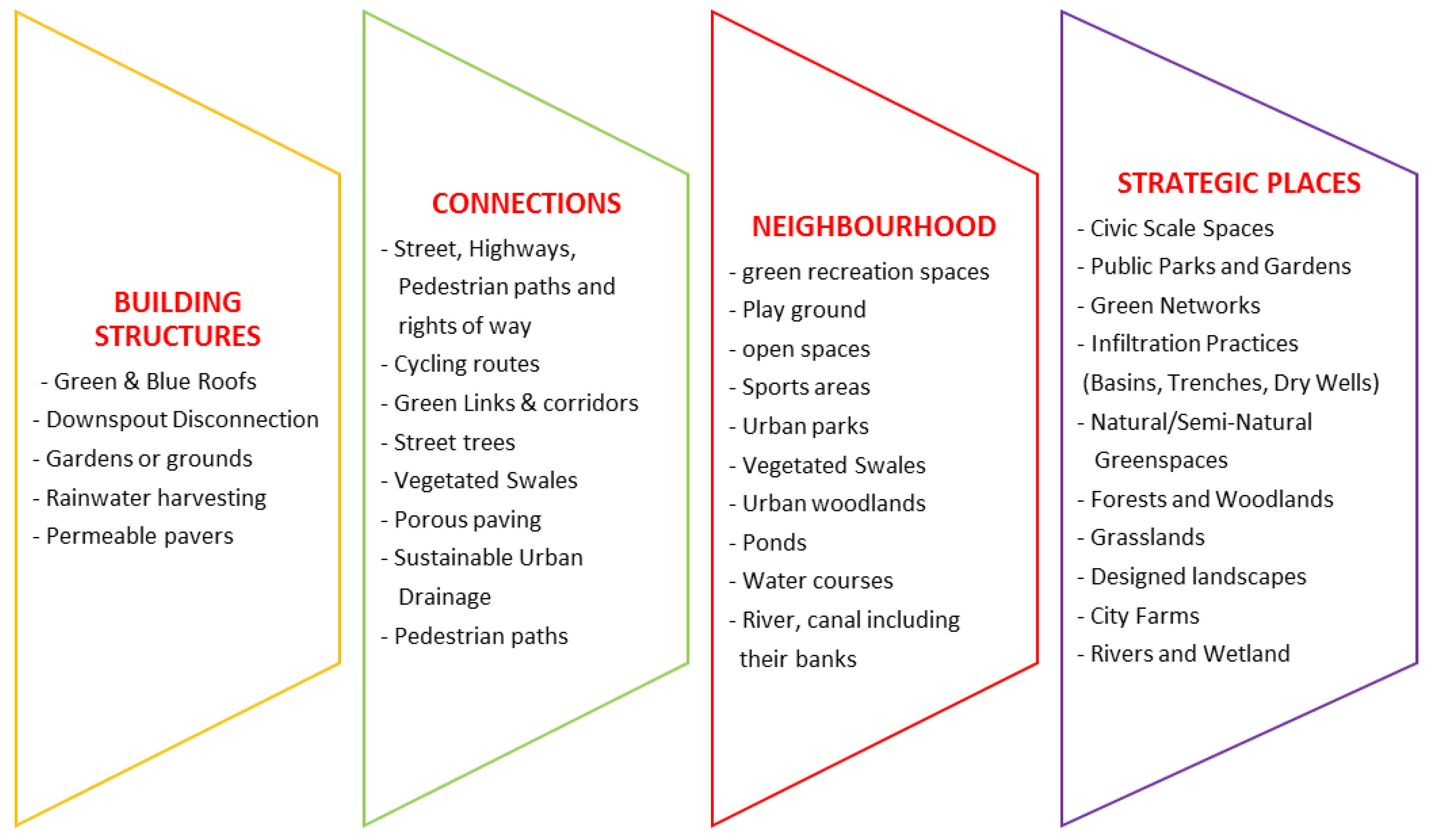
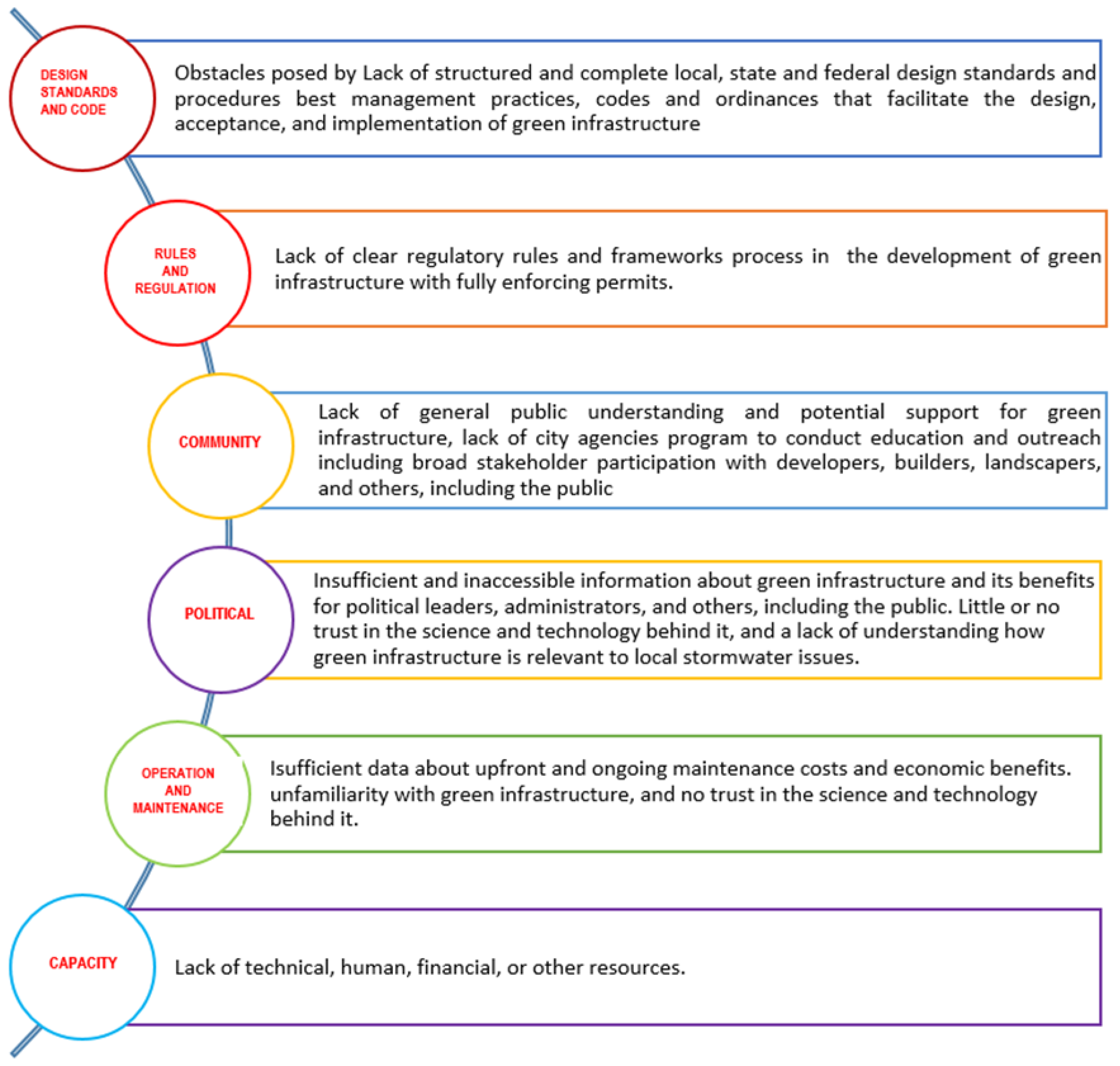

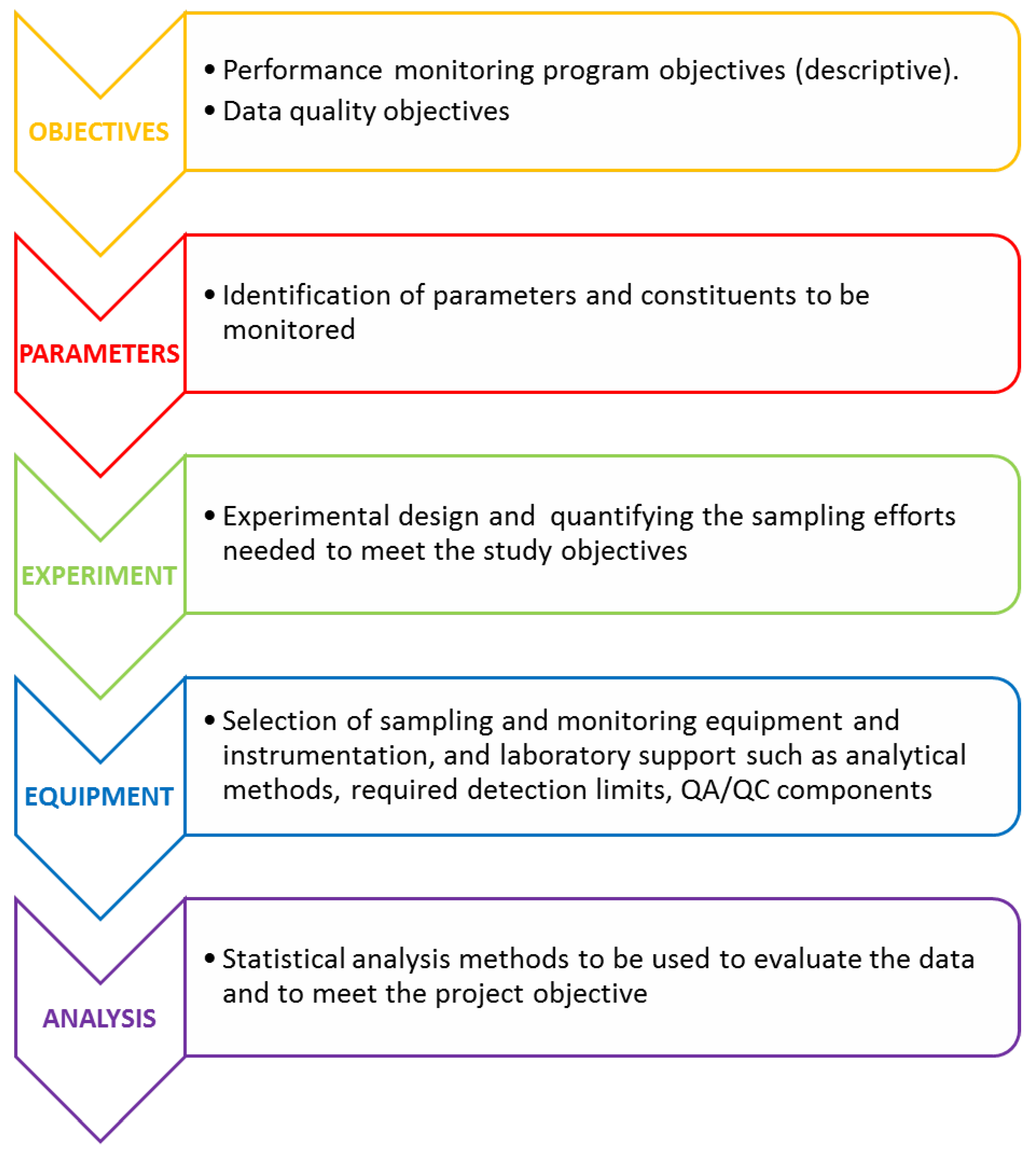
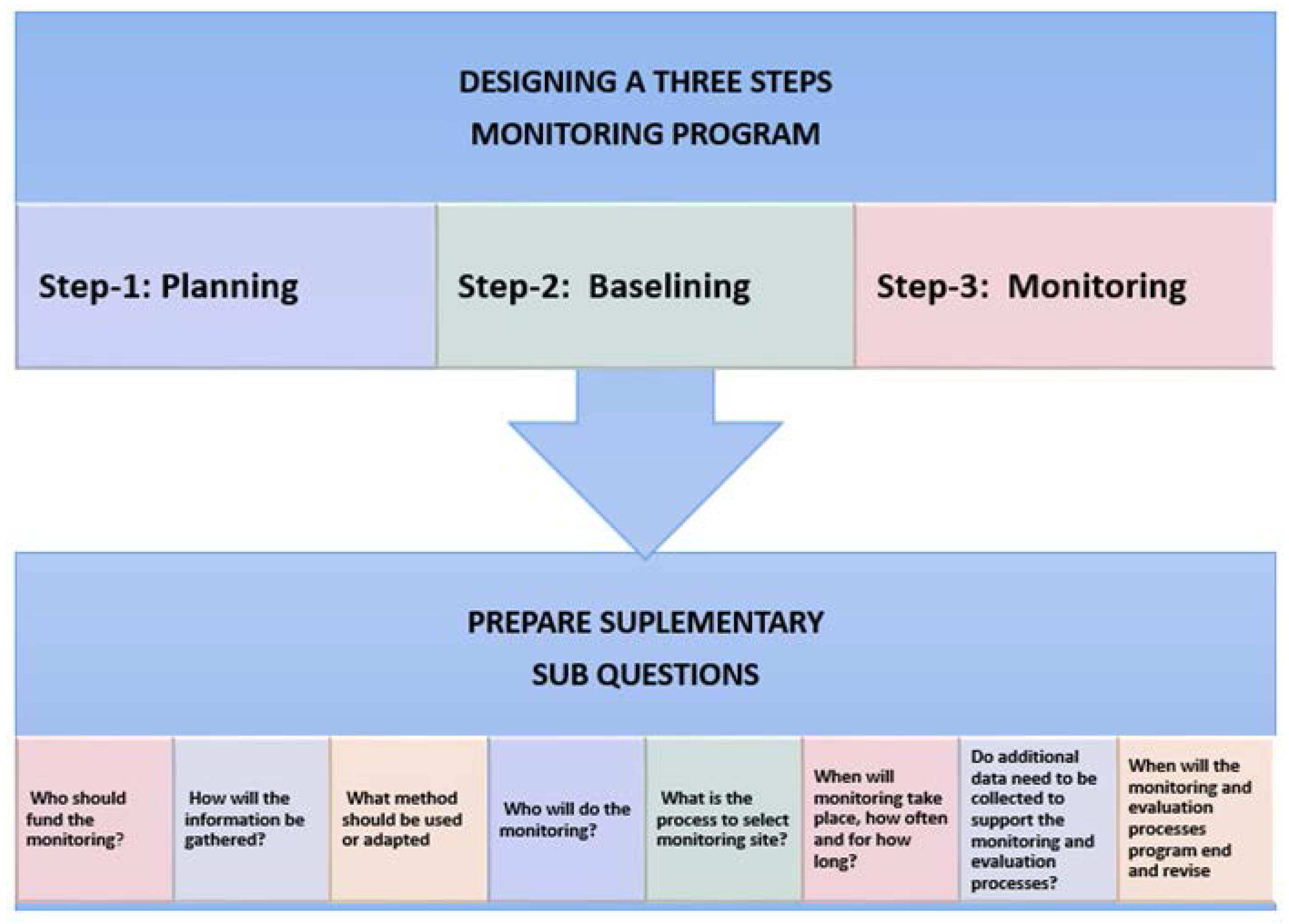
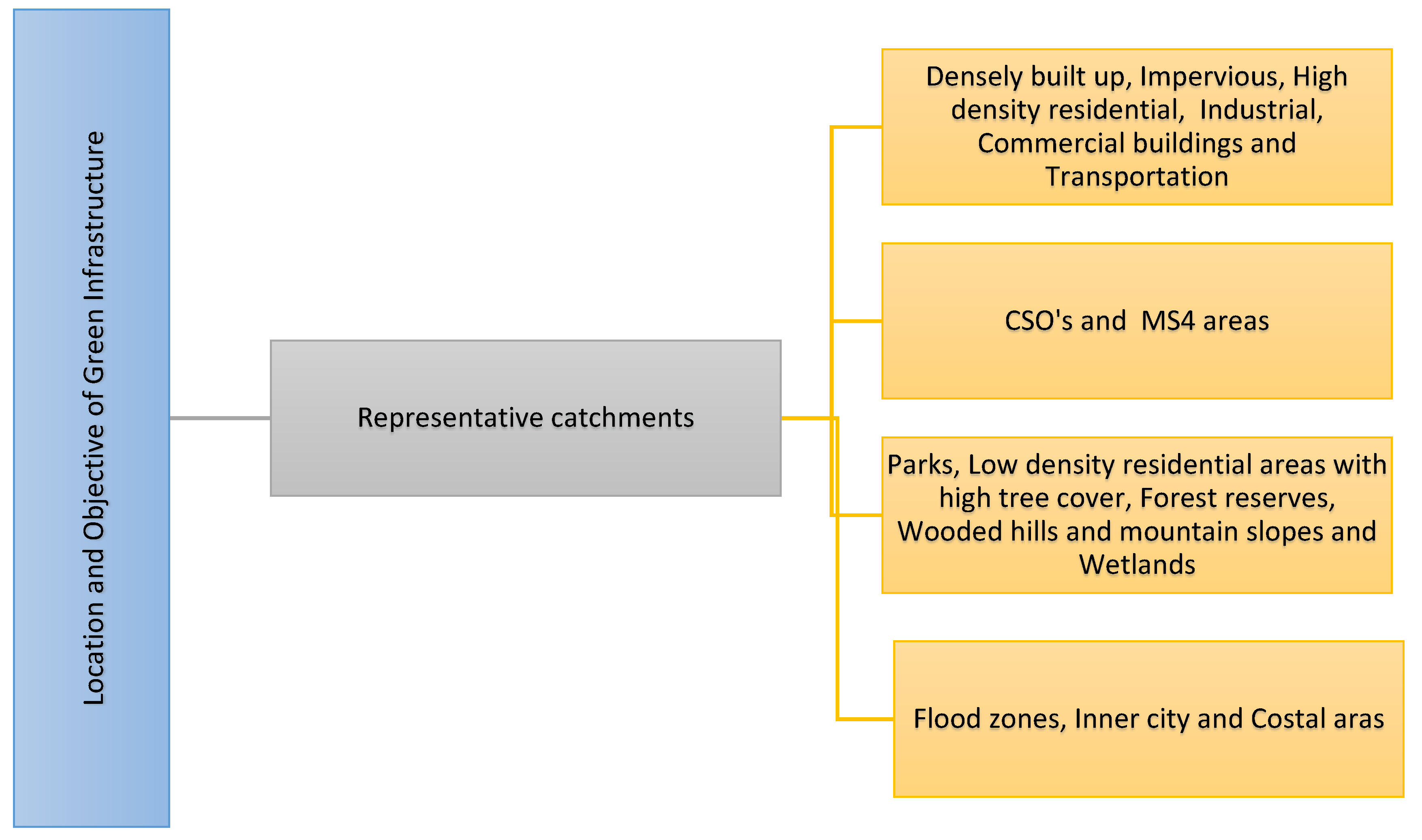


© 2016 by the author. Licensee MDPI, Basel, Switzerland. This article is an open access article distributed under the terms and conditions of the Creative Commons Attribution (CC BY) license ( http://creativecommons.org/licenses/by/4.0/).
Share and Cite
Geberemariam, T.K. Post Construction Green Infrastructure Performance Monitoring Parameters and Their Functional Components. Environments 2017, 4, 2. https://doi.org/10.3390/environments4010002
Geberemariam TK. Post Construction Green Infrastructure Performance Monitoring Parameters and Their Functional Components. Environments. 2017; 4(1):2. https://doi.org/10.3390/environments4010002
Chicago/Turabian StyleGeberemariam, Thewodros K. 2017. "Post Construction Green Infrastructure Performance Monitoring Parameters and Their Functional Components" Environments 4, no. 1: 2. https://doi.org/10.3390/environments4010002




